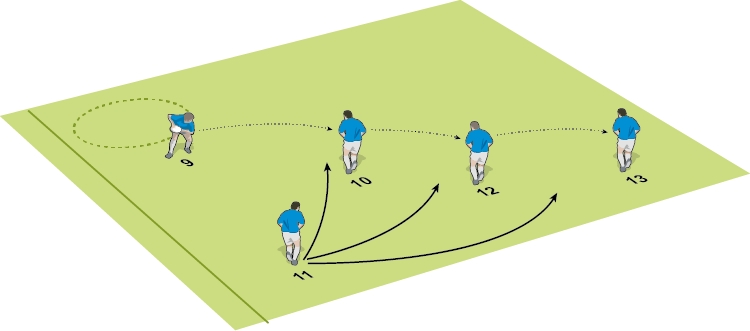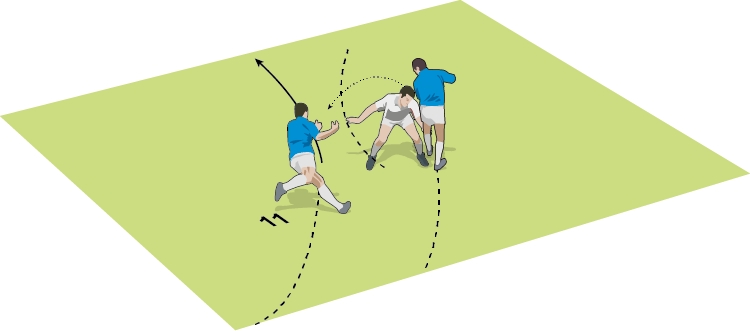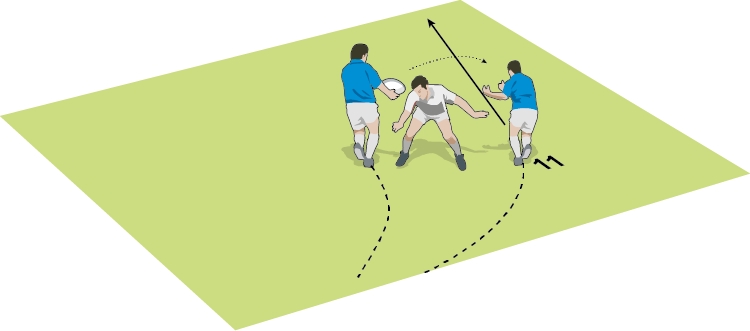Turn your winger into the inside full back
Attack Tacticsby Mark Calverley
Players like Chris Ashton have shown that wingers can come into the line from the blindside and cause havoc. Here’s how to exploit the “inside full back”.
The blindside winger should operate a roaming role and play like an “inside fullback” when the ball is headed towards the opposite side of the pitch. If he keeps inside the ball, it gives options either side of the ball carrier. This works well when the ball carriers are 10, 12 and 13.



One of the key ingredients for success in this area is to be thinking ahead of play. If the winger hugs his touchline, he will be too far away to support. He needs to read the game and begin to move infield ahead of the initial pass from the 9.
If the ball is passed wider he may still be quick enough to catch up and give a supporting option and even help clean up at the breakdown.
Timing is the ingredient that sets the average apart from the very good. The winger needs to be looking at the ball carrier and the distance between him and the opposition tacklers.
His timing should be to target a gap and arrive in it a second before the opposition make the tackle. This way, he doesn’t have to slow down and the opposition cannot react to this surprise strike runner.
There is a strong likelihood that the supporting runs that the winger makes will not end up with him receiving the ball – certainly initially. Other players will have to get used to this dynamic inside support and timing combined with communication increases the chances of receiving the ball.
The winger should read the tackle to increase the chances of receiving the ball. This means that if the ball carrier goes to the left of a defender, for example, the supporting run should be on the right, as this is the easier side for the tackle player to look and pop a pass. The opposite works for right shoulder attack requiring left side support.
Many wingers believe that if they roam they will be out of position when the ball does come to their wing. This is usually untrue but players need the confidence to go looking for the ball and have the support of team mates and coaches to be out of position. If this means that occasionally they are not back in position when they are needed, then that should be accepted in the short term.
These principles can be adapted in to set moves, but actually work best when it becomes a habit and natural instinct for the winger.
At the end of each game ask the winger: “how often you were in place and calling for an inside or outside support pass?”
The blindside winger should operate a roaming role and play like an “inside fullback” when the ball is headed towards the opposite side of the pitch. If he keeps inside the ball, it gives options either side of the ball carrier. This works well when the ball carriers are 10, 12 and 13.

- 11 provides an inside support option for the midfield players.
- All the midfield players should be aware that the winger can be in support.

- If the ball carrier makes the outside break, he should look to pass inside.

- Stepping inside, the ball carrier should look to pass outside.
PROACTIVE NOT REACTIVE
One of the key ingredients for success in this area is to be thinking ahead of play. If the winger hugs his touchline, he will be too far away to support. He needs to read the game and begin to move infield ahead of the initial pass from the 9.
If the ball is passed wider he may still be quick enough to catch up and give a supporting option and even help clean up at the breakdown.
TIMING
Timing is the ingredient that sets the average apart from the very good. The winger needs to be looking at the ball carrier and the distance between him and the opposition tacklers.
His timing should be to target a gap and arrive in it a second before the opposition make the tackle. This way, he doesn’t have to slow down and the opposition cannot react to this surprise strike runner.
PATIENCE
There is a strong likelihood that the supporting runs that the winger makes will not end up with him receiving the ball – certainly initially. Other players will have to get used to this dynamic inside support and timing combined with communication increases the chances of receiving the ball.
READING THE TACKLE
The winger should read the tackle to increase the chances of receiving the ball. This means that if the ball carrier goes to the left of a defender, for example, the supporting run should be on the right, as this is the easier side for the tackle player to look and pop a pass. The opposite works for right shoulder attack requiring left side support.
LICENCE TO ROAM
Many wingers believe that if they roam they will be out of position when the ball does come to their wing. This is usually untrue but players need the confidence to go looking for the ball and have the support of team mates and coaches to be out of position. If this means that occasionally they are not back in position when they are needed, then that should be accepted in the short term.
These principles can be adapted in to set moves, but actually work best when it becomes a habit and natural instinct for the winger.
At the end of each game ask the winger: “how often you were in place and calling for an inside or outside support pass?”
Newsletter Sign Up
Coaches Testimonials

Gerald Kearney, Downtown Las Vegas Soccer Club

Paul Butler, Florida, USA

Rick Shields, Springboro, USA

Tony Green, Pierrefonds Titans, Quebec, Canada
Subscribe Today
Be a more effective, more successful rugby coach
In a recent survey 89% of subscribers said Rugby Coach Weekly makes them more confident, 91% said Rugby Coach Weekly makes them a more effective coach and 93% said Rugby Coach Weekly makes them more inspired.
Get Weekly Inspiration
All the latest techniques and approaches
Rugby Coach Weekly offers proven and easy to use rugby drills, coaching sessions, practice plans, small-sided games, warm-ups, training tips and advice.
We've been at the cutting edge of rugby coaching since we launched in 2005, creating resources for the grassroots youth coach, following best practice from around the world and insights from the professional game.











